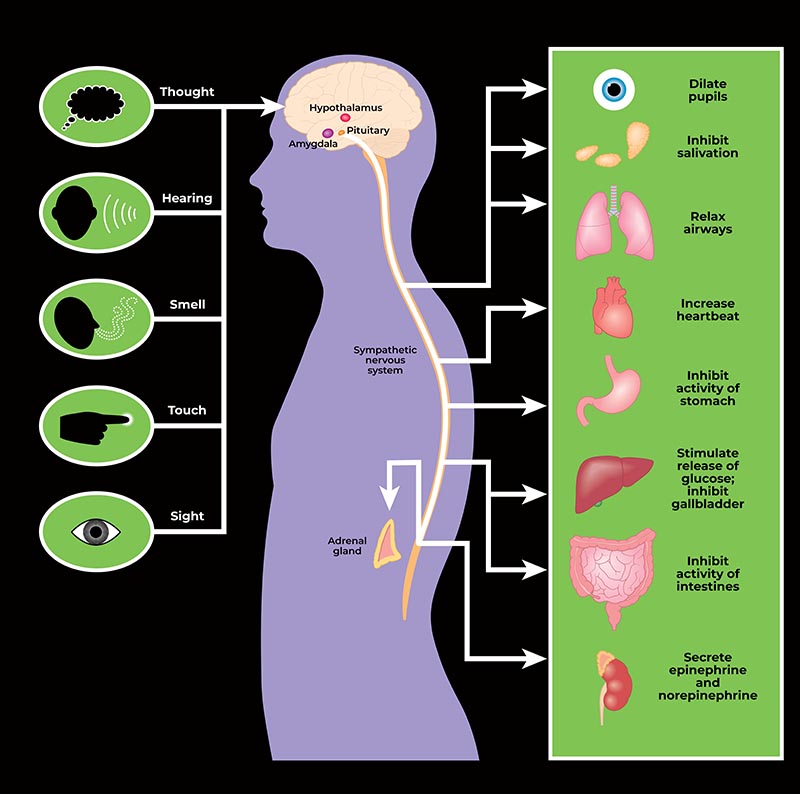Fear. A terrible feeling. Something to avoid.
Right?
Not so fast.
Fear can actually be turned into a powerful asset and opportunity, if understood and addressed properly. Can we get good at overcoming fear?
First, what is it? Fear is a feeling of distress or dread caused by a sense of impending danger or pain. It’s a powerful, primitive emotion. A warning that we need to pay attention.
We need fear to survive, and it has served us well through the ages. But it can also be one of the biggest obstacles in our lives.
We can go through our whole lives trying to avoid the things we’re afraid of, dramatically altering our experience of life.
In that sense, fear is like a force field keeping us in our comfort zone.
How strong is its hold over us?
What lies beyond our fears?
How do we find out?
What Are We Afraid Of?
First, let’s understand what we’re afraid of.
Of course, some people have a phobia (an extreme or irrational fear or aversion of something), such as fear of the dark, heights, flying, spiders, and snakes.
But here, we’re focused on the everyday fears in our lives, work, and social settings that hold us back. It turns out, we have many such fears, including a fear of:
|
|
Entrepreneur and author Ruth Soukup notes that our fears often come not only with negative traits but also positive ones. For example, if we’re afraid of making mistakes, it can lead to procrastination and perfectionism but also high-quality work that’s well organized and error-free. If we fear being judged, it can lead to people-pleasing and failing to set boundaries but also to being a team player who’s thoughtful and fun to be around.
The story is complex. Fear has a ghastly reputation, but it turns out that it isn’t all bad. Far from it. To accept that key insight, first we need to understand what it is, how it works, and why it exists.

Quality of Life Assessment
Evaluate your quality of life in ten key areas by taking our assessment. Discover your strongest areas, and the areas that need work, then act accordingly.
Fear Is a Physiological Phenomenon

Fear isn’t something only for cowards. It’s part of being human. Fear is universal. We all experience it.
Fear is hardwired into our neurobiology, starting in the part of our brain called the amygdala. The feeling of fear is a state of high arousal designed to protect us from harm. It’s a survival response that has evolved over the ages.
When we’re afraid, we become hyper-alert. Our nervous system sets a cascading fear response into motion: our breathing accelerates, and our heart rate and blood pressure rise. Also, our body releases stress hormones like cortisol and adrenaline—sometimes in a flood. Our pupils dilate. Blood flows into our limbs so that we can respond aggressively to a threat by fighting or fleeing.
With all these physical and chemical reactions, we experience impairment of the cerebral cortex, the part of our brain that handles reasoning, judgment, sensation, perception, memory, creative association, and voluntary physical movement. As a result, we don’t think as clearly, and it’s harder to make good decisions. We become preoccupied with the threat.
If left unchecked, fear can become debilitating. It can prevent us from functioning at our best—or even at all.

Take the Traps Test
We all fall into traps in life. Sometimes we’re not even aware of it, and we can’t get out of traps we don’t know we’re in. Evaluate yourself with our Traps Test.
Reframing Fear
Clearly, it’s important for us to learn how to manage fear to avoid situations where it debilitates us. This leads us to two key insights:
1. Fear is often a paper tiger.
The fear of what may happen is often worse than the reality of what actually happens, or what may. It’s a bit like a movie playing in our head—coming from a man in the projection room at the back of a theater.
A fierce tiger appears on our mental screen. The animal seems powerful, with menacing fangs and a terrible roar. Our skin crawls. The hair on our arms stands up. But the tiger, in most cases, is only a scared cat with its own fears.
We experience a raging physiological thunderstorm of fear as if it’s the truth and based in reality. In fact, it’s only an anticipatory reaction to a perceived threat designed to get us ready for combat or avoidance. In the swirl of the storm, we have a hard time distinguishing between what’s real and what’s only possible. Fear is the step in between.
Often the alarm system is overly vigilant and too quick to escalate the alert levels. It gets carried away. We become accustomed to fleeing at the first alert. The synapses in our brain lay an escape path of backward movement: Retreat. Withdrawal. Over time, this becomes habitual and unconscious. We just do it. We avoid. Or we run. So we never move forward in the areas holding us back.
2. Fear signals an opportunity for breakthroughs when we’re able to see it clearly.
It’s a protective layer serving as a boundary between stasis and transcendence. Most people approach the layer and then turn and run.
But learning how to sit with it is the master maneuver. We must learn to recognize that the tiger is a paper one. Because then we can go forward instead of turning back. And that’s where the good stuff is: the challenge, the learning, the development.

Personal Values Exercise
Complete this exercise to identify your personal values. It will help you develop self-awareness, including clarity about what’s most important to you in life and work, and serve as a safe harbor for you to return to when things are tough.
Overcoming Fear: How to Manage Our Fears
So how to do this? How to proceed anyway despite this onslaught of biochemical alerts? Here are 12 steps to help you get good at overcoming fear:
- Spend time with your fears. Study them. Write about them. Get comfortable with them.
- Get gradual exposures to your fears. (That’s what Navy SEALs and NASA astronauts do.)
- Prepare for high-pressure events that tend to trigger your fear alert system. By doing so, you will lower the chance of running into problems and feeling out of control. Practice and role-play in challenging situations. Place yourself in settings that challenge you and see how you can survive, learn, and grow. It helps to have a growth mindset.
- Visualize success. Paint a mental picture of overcoming obstacles and achieving your objectives.
- Gather information to reduce the fear of the unknown. Fear often shrinks or disappears in the face of facts and scrutiny.
- Name the fear and analyze it rationally, including whether there’s a deeper fear behind the immediate fear. (For example, a fear of making a mistake in a presentation can be amplified by an underlying fear of being rejected by the group, or not being valued by others.) Understand it. Embrace it. Use it as fuel for determined action.
- Recall that the fear is usually much worse than the things we’re actually afraid of. Get in the habit of comparing actual outcomes to the worst-case scenarios your amygdala is freaking out about. Note that your amygdala only comprises about 0.3% of your brain’s volume. Don’t let the 0.3% wag the 99.7%.
- Try not to panic. The goal is not to be fearless, as that’s virtually impossible biologically, but rather to learn how to manage your fear and still function effectively. Deep breathing can help calm your mind and body.
- Have a deeper why—a purpose worth wrestling your fear for. (For example, you may face a great challenge at work with a project or initiative that will test your self-worth and resilience but you wisely attach it to your role as a provider in your family and how you can be a role model for your children.)
- Gain perspective and look at the fear in the larger context. (For example, although it may hurt your pride and sense of social standing if you fail on a project, you know that you’ve built up a lot of credibility over the years through your competence and diligence—and that there will likely be many more opportunities to try again in the future.)
- Face the fear and move through it (not away from it). Give yourself experience with confronting and overcoming your fears. This will help build your fear resilience muscles. You’ll start to become a brave person—through your decisions, habits, intellect, and force of will.
- Ask for help. You don’t have to do it alone. We all need help sometimes! (By the way, showing vulnerability by asking for help builds connection.)
In the end, recall that fear is part of being human. It has served us well over the ages, but it also holds us back. If we can learn to “punch fear in the face,” as Jon Acuff put it, we can do so much more of what’s important in life. Be bolder. And get good at overcoming your fears. Your future self will thank you for it.

Reflection Questions on Overcoming Fear
- Which fears are holding you back?
- How long have they kept you fenced in?
- What opportunities lie on the other side of those fears?
- What will you do about it?
Tools for You
- Traps Test (Common Traps of Living) to help you identify what’s getting in the way of your happiness and quality of life
- Quality of Life Assessment so you can discover your strongest areas and the areas that need work, then act accordingly.
- Personal Values Exercise to help you clarify what’s most important to you

Gregg Vanourek’s Newsletter
Join our rapidly growing community. Sign up now and get monthly inspirations (new articles, opportunities, and resources). Welcome!
++++++++++++++++++++++++++++++
Gregg Vanourek is a writer, teacher, TEDx speaker, and coach on personal development and leadership. He is co-author of three books, including LIFE Entrepreneurs: Ordinary People Creating Extraordinary Lives (a manifesto for living with purpose and passion) and Triple Crown Leadership: Building Excellent, Ethical, and Enduring Organizations (a winner of the International Book Awards). Check out his Best Articles or get his monthly newsletter. If you found value in this article, please forward it to a friend. Every little bit helps!

